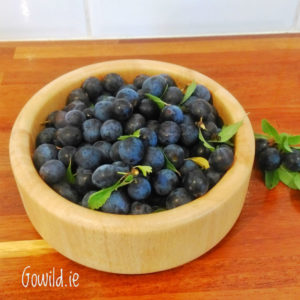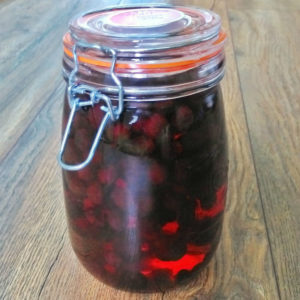 Sloe Gin
Sloe Gin
Or more accurately, ‘Sloe Gin Liqueur’, as you aren’t actually making gin, you’re making a gin based liqueur, so sorry folks, no easy way to make alcohol. It is possible to make alcohol from these bitter little plums, the whitish bloom on the outside of the berry helps in the fermentation process, but there is no straightforward method without having to go out and buy a whole heap of specialist equipment!
And while we’re talking in terms of gin – this drink does not taste even remotely reminiscent of gin by the time it’s ready to drink. So, if like me, you actually can’t stand gin, you will still love this little drink.
Where do I find them?

I do hope that you checked out where your local blackthorn bushes were back in April, as I suggested all the way back then, when they were very easy to identify! If not, the hunt for sloes is a little harder, but if you have spent September picking blackberries and elderberries for jams, tarts and crumbles, you may already have spotted them among the hedgerows. Blackthorn grow along the edges of fields and lanes. Needless to say, if accessing them from the roadside – be careful of traffic – and if accessing fields, be mindful that you may well be trespassing. A knock on the door of a nearby house to ask permission will go a long way.
What do they look like?

They look like dark purple olives, or miniature plums with clusters of oval leaves around the fruit. Although reminiscent of olives, they are actually part of the Rosaceae family – of which many cultivated and wild edibles are, including apples, pears, raspberries, strawberries and blackberries amongst others.
These bitter little fruit are crying out to be used in jelly or liqueur making and indeed an online search of sloes will bring up any amount of recipes. And really, it comes down to taste.
The rule of thumb is to pick them after the first frost, generally early to mid October. I’ve picked them as early as mid-September though – to ensure I get to them before the birds (and maybe other foragers!) and then popped them in the freezer for a few hours/overnight to simulate that first frost and soften up their skins a bit. This hasn’t done any harm to my previous batches of Sloe Gin Liqueur and widens the picking window a tad!!
How much do I need?

You’ll need enough to half fill a 1L Kilner style jar or bottle for each batch you decide to ‘brew’.
Please remember the foraging rule of thirds when picking or you won’t find any sloes to pick in the years to come.
What else do I need to know?
Some recipes call for equivalent amounts of fruit and sugar, most recommend half the amount of sugar as fruit and several hedge their bets with an amount in between. I have tried both the equal and half methods and although I wouldn’t classify myself as having a sweet tooth, I did prefer the additional sugar. The type of sugar used also varies from recipe to recipe. Some prefer demerara sugar whilst others favour castor sugar for its’ ease of dissolving. I wouldn’t get too hung up it, whichever you happen to have in your cupboard will do just fine.
Some recipes add a drop of vanilla essence or a pod, others suggest adding a few peppercorns. Some recommend adding either almond essence (immediately) or some skinned almonds after a few weeks later. With almonds belonging to the same plant family as sloes, these are what I’ve traditionally chosen to use. But this year, I might just go wild and try a variety!!
The gin itself should be of a reasonably good quality. There are an abundance of gins on the market at the moment, so you should find one to suit your pocket without going cheap and nasty!
Sloe Gin Liqueur:
Ingredients
- ½ Kilner style jar of sloes
- Same weight of castor sugar as sloes
- Good quality gin
- Vanilla Pod/Black Peppercorns/Skinned Almonds if desired
Method
- Put the sloes in the jar you plan to use to determine how many you will need. Weigh them.
- Wash your jar and lid in warm soapy water (or in the dishwasher), sterilise them by boiling in water for 10 minutes. If you are making a large batch, consider the oven sterilising method.
- Wash the sloes to remove any little insects and grit.
- If unsure about frost, pop the sloes in a ziplock bag and put them in the freezer for a few hours or overnight. (It doesn’t matter if you leave them longer).
- Prick holes in the sloes with a sterilised needle to help the juices seep out. Do this regardless of freezing.
- Add the sloes to your jar.
- Add the desired amount of sugar.
- Pour in as much gin as the jar will hold.
- Shake to dissolve as much castor sugar as possible.
- Store in a warm place for a minimum of two months, shaking frequently over the first week or so and whenever you happen to think of it thereafter.
- After a few weeks add your skinned almonds/black peppercorns or vanilla pod if you wish.
The longer you leave it, the nicer it becomes….. apparently…..






Comments are closed.